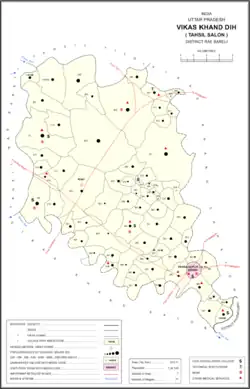Sadipur Kotwa
Sadipur Kotwa is a village in Dih block of Rae Bareli district, Uttar Pradesh, India.[2] It is located 20 km from Raebareli, the district headquarters.[3] As of 2011, it has a population of 1,850 people, in 320 households.[2] It has one primary school and no healthcare facilities, and it does not host a permanent market or weekly haat.[2] It belongs to the nyaya panchayat of Dih.[4]
Sadipur Kotwa
Sādipur Kotwa | |
|---|---|
Village | |
 Map showing Sadipur Kotwa (#327) in Dih CD block | |
 Sadipur Kotwa Location in Uttar Pradesh, India | |
| Coordinates: 26.126084°N 81.384388°E[1] | |
| Country | |
| State | Uttar Pradesh |
| District | Raebareli |
| Area | |
| • Total | 1.734 km2 (0.670 sq mi) |
| Population (2011)[2] | |
| • Total | 1,850 |
| • Density | 1,100/km2 (2,800/sq mi) |
| Languages | |
| • Official | Hindi |
| Time zone | UTC+5:30 (IST) |
| Vehicle registration | UP-35 |
The 1951 census recorded Sadipur Kotwa as comprising 5 hamlets, with a total population of 600 people (312 male and 288 female), in 120 households and 110 physical houses.[5] The area of the village was given as 559 acres.[5] 17 residents were literate, 16 male and 1 female.[5] The village was listed as belonging to the pargana of Parshadepur and the thana of Nasirabad.[5]
The 1961 census recorded Sadipur Kotwa as comprising 4 hamlets, with a total population of 638 people (337 male and 301 female), in 130 households and 122 physical houses.[6] The area of the village was given as 559 acres.[6]
The 1981 census recorded Sadipur Kotwa as having a population of 904 people, in 241 households, and having an area of 234.32 hectares.[3] The main staple foods were listed as wheat and rice.[3]
The 1991 census recorded Sadipur Kotwa as having a total population of 1,054 people (549 male and 505 female), in 211 households and 209 physical houses.[4] The area of the village was listed as 234 hectares.[4] Members of the 0-6 age group numbered 179, or 17% of the total; this group was 50% male (90) and 50% female (89).[4] Members of scheduled castes made up 22% of the village's population, while no members of scheduled tribes were recorded.[4] The literacy rate of the village was 18% (173 men and 18 women).[4] 323 people were classified as main workers (300 men and 23 women), while 0 people were classified as marginal workers; the remaining 731 residents were non-workers.[4] The breakdown of main workers by employment category was as follows: 303 cultivators (i.e. people who owned or leased their own land); 6 agricultural labourers (i.e. people who worked someone else's land in return for payment); 0 workers in livestock, forestry, fishing, hunting, plantations, orchards, etc.; 0 in mining and quarrying; 1 household industry worker; 1 worker employed in other manufacturing, processing, service, and repair roles; 0 construction workers; 3 employed in trade and commerce; 1 employed in transport, storage, and communications; and 8 in other services.[4]
References
- "Geonames Search". Do a radial search using these coordinates here.
- "Census of India 2011: Uttar Pradesh District Census Handbook - Rae Bareli, Part A (Village and Town Directory)" (PDF). Census 2011 India. pp. 393–409. Retrieved 15 October 2021.
- Census 1981 Uttar Pradesh: District Census Handbook Part XIII-A: Village & Town Directory, District Rae Bareli (PDF). 1982. pp. 212–3. Retrieved 15 October 2021.
- Census 1991 Series-25 Uttar Pradesh Part-XII B Village & Townwise Primary Census Abstract District Census Handbook District Raebareli (PDF). 1992. pp. xxiv–xxviii, 240–1. Retrieved 15 October 2021.
- Census of India, 1951: District Census Handbook Uttar Pradesh (42 - Rae Bareli District) (PDF). Allahabad. 1955. pp. 168–9. Retrieved 15 October 2021.
{{cite book}}: CS1 maint: location missing publisher (link) - Census 1961: District Census Handbook, Uttar Pradesh (39 - Raebareli District) (PDF). Lucknow. 1965. pp. cii-ciii of section "Salon Tahsil". Retrieved 15 October 2021.
{{cite book}}: CS1 maint: location missing publisher (link)